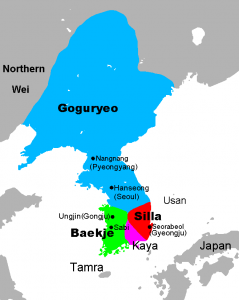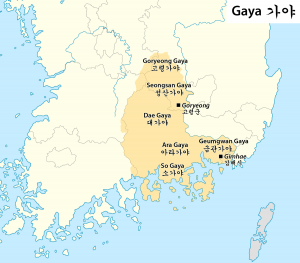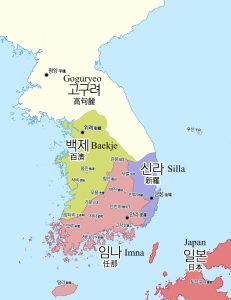Lauren Stover

An overview of Gaya
When discussing the Three Kingdoms period, there has been a lot of research and archaeology on the states of Goguryeo, Baekje, and Silla, but only in the last few decades has research looked into Gaya, so much of Gaya’s history is unknown. So although we know Gaya was located in the central southern portion of the Korean peninsula between Baekje and Silla, the exact borders and towns that made up the confederacy aren’t as well known and can vary depending on which sources are providing the information.[1] The founding of Gaya dates from between the 1st and 2nd century, depending on if the Byeonhan Confedacy of the Samhan Period is included as Early Gaya history.[2] As for the specifics to the founding of the Gaya Confederacies, one myth claims that six golden eggs came down from heaven and after twelve days they hatched and out came the first rulers of the six Gayas.
We know of the Gaya foundation myth because it was recorded, but the specifics of life and politics in Gaya remains hazy due to insufficient information from texts. Gaya was mentioned occasionally in contemporary Chinese texts like the Sanguozhi (Record of the Three [Chinese] Kingdoms), this provides context on the Samhan Period and Early Gaya, and the Nan Qishu (History of the Southern Qi), which has a section known as “The Account of the State of Kara” and mentions a tributary mission by the ruler of Daegaya dispatched to the Southern Qi court.[3] The Goryeo dynasty text the Samguk Sagi (Historical Records of the Three [Korean] Kingdoms) also mentions Gaya occasionally in the Silla Annals and is basis for the proposed chronology of Gaya, but the early history from this text has several inconsistencies which questions the accuracy of the chronology.[4] Although parts were annexed over the centuries by Baekje and Silla, the last of the Gaya Confederacy fell to Silla in 562 CE.[5]

The Gaya-Mimana conflict
As one of the first steps to building their own empire, Japan invaded the Korean Peninsula in 1910. One of the justifications for this action came from the argument that the Gaya Confederacy was actually a Japanese colony known as Mimana. Thus Japan was claiming back land which it had lost over one millennia ago when Silla annexed the last of Gaya. This argument also didn’t come out of thin air, a Japanese text from the 8th century CE supported this reclamation.[6]
Historical context of the Gaya-Mimana conflict
Although this may appear to be a convenient justification to invade and one with no evidence, a Japanese text from the 8th century CE actually supported this idea.
The Japanese text the Nihon Shoki was compiled in 720 CE.[7] This text is the second oldest Japanese history text and is treated as the essential to and the basis of Japanese history. It includes detailed information on the founding myths of Japan through the reigns of Japanese emperors up to the completion of the text, but there is also information in the Nihon Shoki on the relationship between Japan and the Korean Peninsula, including with Gaya (which in Japanese sources is called Mimana or Imna). In regards to the Korean Peninsula, the text covers many topics including delegations sent and received by the Japanese state of Yamato (also known as Wa), movement of the Yamato-Wa troops and wars fought with the Korean Peninsula, and even mentions important events on the Korean Peninsula, some of which include Gaya.
This text clearly shows that Yamato-Wa and the Korean Peninsula interacted with one another, but Japanese scholars in the 19th and 20th centuries claimed the relationship between these two went further: Yamato-Wa had control over part of the Korean Peninsula, specifically Gaya. This mainly came from sections which discuss the establishment of colonies somewhere to the west of Yamato-Wa.[8] Japanese scholars in the 19th and 20th centuries then claimed that the colony known in the Nihon Shoki as Mimana was actually the same as the Korean Gaya Confederacy.

Problems with the Nihon Shoki
However, there are serious issues with the validity of some events in the Nihon Shoki. For one, the chronology including Korean events doesn’t have any events that match those recorded in the Samguk Sagi and Samguk Yusa (Memorabilia of the Three [Korean] Kingdoms).[9] In regards to the colonies which Yamato-Wa claimed to have settled, some of them have evidence to support this claim, but the exact location of many of these colonies, including Mimana, is unclear and has led to speculation on if they existed at all. Some of the colonies which the Nihon Shoki claims to have been founded in some years by the emperors were done so in years when there was no emperor according to other part of the Nihon Shoki, which weakens the accuracy of the document overall.[10]
More recent takes on the Gaya-Mimana conflict
Due to the use of Gaya by the Japanese as a justification for the Occupation of Korea, which by Korean accounts at least was quite brutal at times, Korean scholars have pushed back against the idea that Gaya and Mimana were the same and have presented other theories instead. One theory as proposed by a North Korean scholar actually claims Mimana was a Gaya settlement on the Japanese mainland, and if this were true, would have interesting implications about who owns Japan.[11] The current most commonly accepted theory by scholars on both sides is that Mimana was some sort of embassy in Gaya to help facilitate diplomatic relations between Gaya and Japan.[12] It is unlikely either side will ever definitively prove their argument, at least not in the near future, and will likely continue the debate over the Gaya-Mimana conflict.
Addressing the use and abuse of Gaya in history
One of the most important things to note about this entire conflict is that both the Korean and Japanese sides have an agenda when it comes to how they want Gaya to be presented. For the Japanese it gives them a claim to a portion of the Korean Peninsula while Koreans see it as another, though perhaps less relevant, Korean state during the Three Kingdoms period. This leads to what could be viewed by some as biased materials to even look at when trying to delve into this topic. Documents from both sides use strong language to try and disprove the other’s argument while bolstering their own, and the thing is there isn’t enough conclusive evidence to prove either correct. This may lead to claiming without definitive proof Gaya and Mimana were one and the same, but it may also be used to claim texts like the Nihon Shoki are entirely fabricated with no actual truth to them.
This bias is something that can be found in many historical documents and is something someone reading history should keep in mind. There was a reason for the creation of each document and even some texts like the Nihon Shoki or Samguk Sagi which are presented as being historical records likely have some bias in how they present certain events. Pair this with a general lack of evidence in any particular event in history and the facts which are known can be presented in ways to further one side’s agenda.
Bibliography
Farris, William Wayne. “Ancient Japan’s Korean Connection.” In Sacred Texts and Buried Treasures, 55–122. Issues on the Historical Archaeology of Ancient Japan. University of Hawai’i Press, 1998. https://www.jstor.org/stable/j.ctt6wqxt7.7.
Choi, Jae-sok. Ancient Korea-Japan Relations and the Nihonshoki. Oxford: Bardwell Press, 2011.
Kim, Jinwung. A History of Korea: From “Land of the Morning Calm” to States in Conflict. Bloomington, Indiana: Indiana University Press, 2012.
Kim, Taesik. “Sources for the Study of Kaya History.” In The Rediscovery of Kaya in History and Archaeology, Early Korea 3. Cambridge, MA: Korea Institute, Harvard University, 2012.
Byington, Mark E. “Editor’s Introduction.” In The Rediscovery of Kaya in History and Archaeology, Early Korea 3. Cambridge, MA: Korea Institute, Harvard University, 2012.
- Mark E. Byington, “Editor’s Introduction,” in The Rediscovery of Kaya in History and Archaeology, Early Korea 3 (Cambridge, MA: Korea Institute, Harvard University, 2012), 8. ↵
- Mark E. Byington, 10. ↵
- Taesik Kim, “Sources for the Study of Kaya History,” in The Rediscovery of Kaya in History and Archaeology, Early Korea 3 (Cambridge, MA: Korea Institute, Harvard University, 2012), 18. ↵
- Taesik Kim, 19. ↵
- Kim Taesik, 41. ↵
- For more information on the archaeology of Gaya, and its interpretation, see the next chapter. ↵
- Kim Taesik, “Sources for the Study of Kaya History.” ↵
- Jae-sok Choi, Ancient Korea-Japan Relations and the Nihonshoki, 190. ↵
- Farris, “Ancient Japan’s Korean Connection,” 65. ↵
- Jinwung Kim, A History of Korea: From “Land of the Morning Calm” to States in Conflict, 48. ↵
- Jae-sok Choi, 253. ↵
- Jae-sok Choi, 253. ↵
